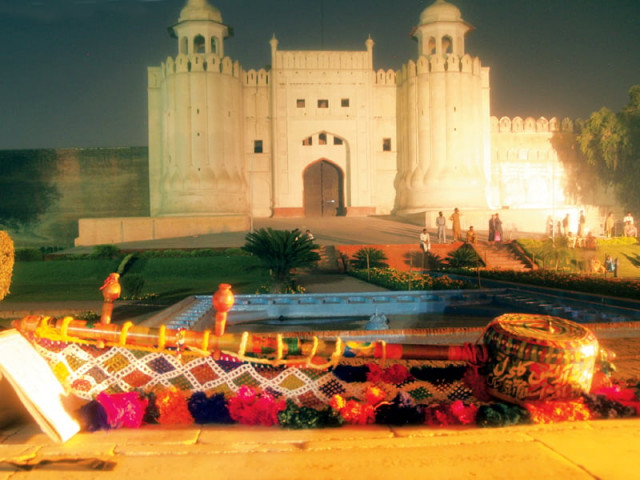Sangeet Akath: For the sake of folk
‘Sangeet Akath’ was held at Lahore’s Hazoori Bagh.

Decorated with colourful streamers and encompassing a unique sense of history, the concert and poetry recital ‘Sangeet Akath’ held at Hazoori Bagh on November 14, was a journey into Lahore’s old city culture. The evening witnessed folk singers and poets giving tribute to Waris Shah’s love story “Heer Ranjha” and exploring Sufi poetry.
Organised by the Trust for History, Art and Architecture of Pakistan (THAAP) with the patronage of Lok Rahs, a not-for-profit, volunteer based theatre and arts organisation, the event tried to transcend the class boundaries by going door-to-door to invite local residents. The audience comprised of a diverse array of people, as aside from the ‘well-to-do’ crowd, the gathering included Sikh pilgrims and residents from the area as well.
Dressed in a vibrant outfit embellished with strings of beads and a carefully-fitted turban, Krishan Lal Bheel, an accomplished folk singer from Cholistan, sang in several languages including Marwari, Saraiki, Punjabi and Urdu during his live performance. He stated, “No matter if you’re a big or a small person, you’re always searching for truth — that’s why Sufi music is important today.” He added, “A dervish goes on God’s path, that why other musical styles come and go, plastic and paper music will break, but Sufi music will live on.”
Many of the folk performers at the event also had unique story; for instance Malik Shaukat Ali, a rickshaw driver by profession, rendered witty Punjabi poetry and pointed out the importance of promoting it. Despite not being able read, Ali has done a lot to promote Punjabi folk tales and has frequently bought Punjabi story books with his salary and distributed them amongst people. Other performers such as Sain Mushtaq and Sain Ajaz from Sheikhupura and Arif Sulehri from Narowal gave impressive vocal performances.
A 25-member Punjabi dhol performance saw energetic street drummers entertaining the audience. At the end of the night, the audience went away knowing that indigenous folk music still has a profound impact on local mainstream culture.
The historical context of Hazoori Bagh also provides an insight to the area. This garden was built by Maharajah Ranjit Singh, the first emperor of the Sikh empire, in 1813 to celebrate his capture of the famous Koh-i-Noor Diamond from Shah Shujah of Afghanistan. The Hazoori Bagh is bounded by the Lahore Fort (East), Badshahi Mosque (West) and the mausoleum of Maharaja Ranjit Singh (North). Used as a katcheri, where petty disputes were discussed during the British Raj, it later became a public space used for the community’s local recitals and entertainment.
“This has been a cultural space for 200 years, because open spaces in Lahore were always limited,” says Qamar Zahoor, an event organiser. “It allows us to explore the beauty of our culture and spiritual heritage.”
Published in The Express Tribune, November 17th, 2011.



















COMMENTS
Comments are moderated and generally will be posted if they are on-topic and not abusive.
For more information, please see our Comments FAQ